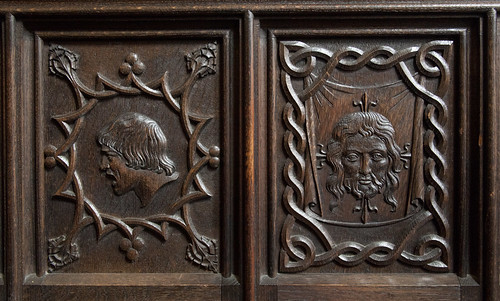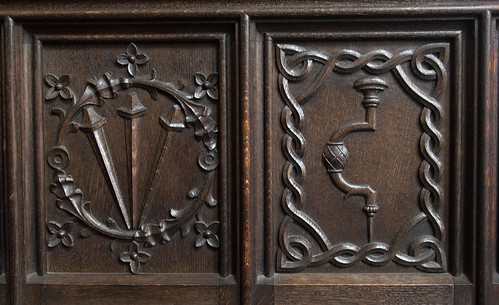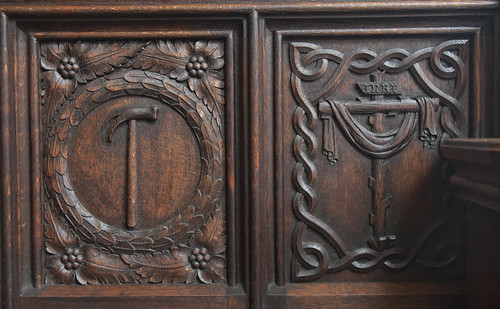 |
| The mocking of Christ; Veronica's handkerchief. |
1: Leon Podles' argument about masculinity.
2: How Podles thinks the Church became feminised in the High Middle Ages
3. Doubts about Podles' historical argument.
4. The role of Rationalism and Romanticism in confirming the feminine image of the Church.
5. The liturgy, and a solution to the problem.
Western spirituality took an emotional and interior turn in the High Middle Ages. This is undeniable; you can see it in the art and in the devotional manuals. Podles tells us that the interior life and the emotions are things with which women are more comfortable than men; men, he says, disclose themselves through action, women through words. That may be true, but to take one thing at a time, emotions are not the exclusive preserve of women, and an integration of the emotional life into spirituality is not a bad thing. Jesus expressed strong emotions - joy, anger, grief: there is nothing unmanly about that. They are not, from any point of view, suffocating feminine emotions. Again, the emotional religious art of the Gothic and indeed Baroque eras is not, as Podles appears to suggest, concerned exclusively with the overheated maternal instincts of cloistered nuns contemplating the Crib; the focus is actually on the Passion. (That is why I am decorating these posts with the Instruments of the Passion carved into the choir stalls of a former Anglican convent.) To use one of Podles' favourite words, the focus of this devotion is agonic (as in agonistic), and to that extent potentially appealing to men.
Even the devotions associated with the Nativity, and the Five Wounds (the precursor to the Sacred Heart and Divine Mercy devotions), are concerned above all with the mystery of the Incarnation, and the Sacred Humanity of Our Lord. Yes it can be sentimental, but it need not be. The Wounds, of course, lead us back to the Passion. The Divine Mercy is the flip side of God's Justice and the coming punishment.
Again, an emotional turn can be seen in the devotional art of the East as well as the West, and Podles tells us that in the East they don't have the problem he has identified in the West.
The focus on the interior life is, again, not necessarily feminine. It can be the scene of smaltzy meditations on the boyhood of Jesus, but it can be more like what is described by Hopkins: the inner version of the desert where the early monks went to do battle with the devil.
O the mind, mind has mountains; cliffs of fall
Frightful, sheer, no-man-fathomed. Hold them cheap
May who ne'er hung there.
Again, Podles' distrust of Scholasticism seems a bit over-egged to me. The thing about Scholasticism, and Aristotelianism, is the integration of the body and the emotions into its view of human nature. Scholastic theology may be intellectual, but its understanding of human agency is far more balanced than that of Platonism before it or the Enlightenment thinkers after it.
 |
| The nails of the Crucifixion; a drill to make the holes in the Cross. |
There is no 'alienation of the men' [in the Catholic Church]; on the contrary, in this country, as also in Italy and France, I am continually astonished by the extraordinary predominance of the male sex over the female in attendance at Mass and in the practice of private prayers in our churches. As a recent casual occasion, upon my remarking to the parish-priest of a suburban church of this phenomenon, he told me that on the previous evening he had happened to count the congregation from the west gallery and that the proportion of men to women had been about as two to one. This, of course, was something of an exceptional illustration of my point.
...
Again, I must emphatically deny that formalism is characteristic of Catholicism in a way that it is not characteristic of Protestantism. There is, however, just this shadow of truth in the charge; viz., that amongst Catholics emotionalism and even strong sentiment is considerably discouraged, and that the heart of religion is thought rather to reside in the adherence and obedience of the will. The result is, of course, that persons of a comparatively undevout nature will, as Catholics, continue to practice their religion, and sometimes, in ungenerous characters, only the barest minimum of their obligations; whereas as Anglicans they would give it up altogether.
An evening congregation before the First World War would not, of course, have been attending Mass; it would presumably have been Benediction, or some other devotion, which makes the observation all the more remarkable.
Benson's experience is directly related to an issue I have discussed on this blog before: the success of the Catholic Church in Britain to attract and retain working class men in the 19th and early 20th centuries. Indeed, it was the only denomenation in this country ever to have a large-scale following among the industrial working classes. As well as many converts (conversions were about to sky-rocket when Benson was writing), one of the greatest achievements of the mid and late-19th century Catholic Church here was the successful absorption of a vast number of Irish immigrants, who were suffering exactly the kind of social dislocation which created the 'unchurched' working class out of English Anglican farm labourers moving to the cities. The explanation, given by the sociologist Anthony Archer, focuses on the Catholic Church's critical distance from the English Establishment (he also has interesting things to say about the liturgy). The same of course would be the case in the United States and other parts of the English-speaking world, but the opposite was true at that time in many historically Catholic countries, where the Catholic Church could be associated, not always fairly, with the establishment and / or the Ancien Régime.
My suggestion would be that this political association had a greater effect on men than on women, since (in this period: 19th and early 20th centuries) men were more politically engaged than women. There was a degree of feminisation going on, including in England: just have a look at some of period's hymns. (The most awful ones have not, of course, survived in the repertoire today, though the tune for St Alphonsus' 'Glory be to Jesus' deserves some kind of prize.) But sentimentality was interacting with other factors.
As soon as you get down to details, things become complicated. There are always a complex of factors at work, some reinforcing, others counteracting. Just to make things really complicated, I want to introduce another set of factors not dealt with by Podles: the big players in the history of ideas after the 16th century were, successively, Enlightenment Rationalism and Romanticism. An issue for another post.
 |
| The hammer for the Crucifixion; the Cross following the Deposition. |
Podles has also ignored the phenomenon of Methodism, which, although heavily orientated to emotionalism, had an appeal to the working class of both sexes that rivalled that of Catholicism right up until the mid twentieth century.
ReplyDeleteAnthony Archer says the Methodists only appealed to the (lower) professional classes. It was a religion of respectability.
DeleteCatholicism is a Faith of love, and of sacrifice.
ReplyDeletePost- Roman British Catholicism (which supplied St Patrick to Ireland), merged with the Augustinian Anglo Saxon Church, which was not effeminate, their European cousins saving Catholicism later at Tours.
This continued throughout the barbarian assaults through the 10th century, and the attempts to win back the Holy Lands lost to Islam, the Crusades until 1291, and then the ongoing campaign of recovering Spain from Islam up to 1492.
Until the sixteenth century, sacrifice and protection predominated - whatever feminine aspects grew from the 12th century.
Benson notes this masculinity was still there in the early 20th century and it certainly was so in my youth in the 1950s.
But yes, something went badly wrong post Vat II